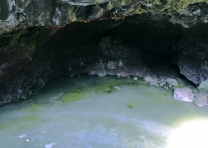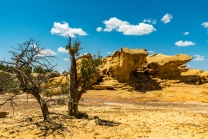No video yet

El Morro National Monument
El Morro National Monument is located on an ancient east-west trail in western New Mexico. The main feature of this National Monument is a great sandstone promontory with a pool of water at its base.
As a shaded oasis in the western U.S. desert, this site has seen many centuries of travelers. The remains of a mesa top pueblo are atop the promontory where between about 1275 to 1350 AD, up to 1500 people lived in this 875 room pueblo. The Spaniard explorers called it El Morro (The Headland). The Zuni Indians call it "A'ts'ina" (Place of writings on the rock). Anglo-Americans called it Inscription Rock. Travelers left signatures, names, dates, and stories of their treks. While some of the inscriptions are fading, there are still many that can be seen today, some dating to the 17th century. Among the Anglo-American emigrants who left their names there in 1858 were several members of the Rose-Baley Party, including Leonard Rose and John Udell. Some petroglyphs and carvings were made by the Ancestral Puebloan centuries before Europeans started making their mark. In 1906, U.S. federal law prohibited further carving.
The many inscriptions, water pool, pueblo ruins, and top of the promontory are all accessible via park trails.
It is on the Trails of the Ancients Byway, one of the designated New Mexico Scenic Byways.
El Morro National Monument has been featured in the film Four Faces West (1948) starring Joel...








